Maria Camila Lopez Duarte, PhD Student, Department of Animal Sciences, Kalyn Waters, UF/IFAS Extension Holmes County, Nick Simmons, UF/IFAS Extension Escambia County, & Angela Gonella, Cattle Reproduction Specialist, UF/IFAS North Florida Research and Education Center
Introduction
The most recent survey by the USDA explains that only 31.6% of beef producers in the U.S. use any pregnancy diagnosis tool (NAHMS, 2020). When comparing cattle operations according to their size (Figure 1), it is evident that the adoption of this technology is still far from being ideal. Large operations (200 or more cows) adopt more of this technology than small (1 to 49 cows) or medium (50 to 199 cows) operations, but there is still room for improvement, independent of the size of the operation. However, it is also evident that small operations are the ones that make the least use of this technology, and therefore, extension efforts have been focused on this segment, and new technology has been developed to facilitate its adoption.
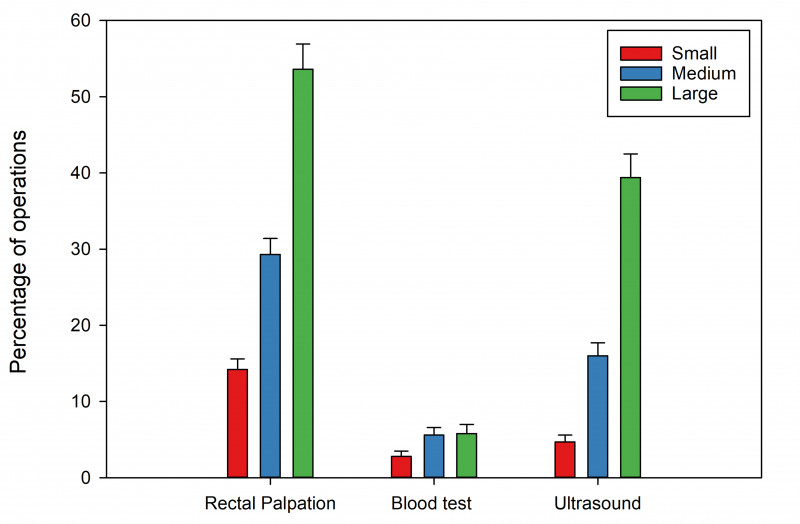
Figure 1: Adoption of rectal palpation, blood test, or transrectal ultrasonography for pregnancy diagnosis in beef operation in the United States. This graph was created using data from NAHNS, 2020.
–
Identifying productive beef females within the herd allows producers to manage their bottom line. In the beef industry, a standard expectation is that females should produce one calf every year. By using pregnancy diagnosis, producers can identify the pregnancy status of females within ± 30 days after breeding instead of waiting for the entire gestation (±283 days). This allows them to choose the future of the animal: rebreed or cull them (Youngquist, 2007). Three methodologies of pregnancy diagnosis are currently available for beef cattle producers. Next, we will give details and explain the main advantages and disadvantages of each one.
–
Rectal Palpation
Rectal palpation is the oldest, simplest, and most common method used in beef cattle. It requires a trained technician or a veterinarian to ensure accuracy, but results are available in real time.
The diagnosis can be made anytime from 30 to 40 days after breeding, depending on the technician’s skill, until pregnancy is full term (±283 days). The technician will use their skills to find the uterine horns of the cow through its rectum. After feeling the structures, they will identify changes in the anatomy, such as size of the uterine horns, fluid in the uterine horns, fetal membranes, placentomes (union between the placenta and the uterus), and even the fetus can be identified depending on the age of the pregnancy (Taverne & Noakes, 2018; Youngquist, 2007). In animals with less than 45 days post-breeding, it is recommended that rectal palpation is only performed by licensed vets or embryologists due to the risk of causing abortion.
As with any test, there is not 100% accuracy for the result given by the technician; some conditions could be palpated and confused as pregnancy, such as incomplete uterus involution, pyometra (infection in the uterus), mucometra (mucus in the uterus), hydrometra (water in the uterus) and if the technician does not have enough experience, it could mistake other structures like the rumen or a kidney for the uterus (Taverne & Noakes, 2018; Youngquist, 2007).
–
Ultrasound
Over the last decade, ultrasonography has become more widely used in the cattle industry and is recommended for pregnancy diagnosis (Filho et al., 2020; Peixoto et al., 2021). Similar to transrectal palpation, the results are given at the time of the exam. Technician skills and training increase the accuracy of the diagnosis using ultrasound (Balhara et al., 2013).
This exam can be performed with accurate results starting at 28 days of gestation; the procedure is like rectal palpation with the difference that the technician will introduce the ultrasound probe with their hand in the rectum of the cow and will look at the monitor of the ultrasound to find the image of the uterus and the uterine horns, after that with soft movements the technician will look for signs of pregnancy. Pregnancy can be seen by the presence of fluid, a small fetus or a completely differentiated fetus, the heartbeat of the embryo, and embryonic membranes (Figure 2)(Szenci, 2021; Youngquist, 2007). Another advantage of this exam is that it can provide more information like the age of the pregnancy, size of the fetus, sex, twins, status of the ovaries, and more (Balhara et al., 2013; Fricke et al., 2016; Taverne & Noakes, 2018). There are still chances to have an incorrect diagnosis, depending on the skills of the technician, the time of the pregnancy in which the exam is performed, and conditions that will result in an accumulation of fluid in the horns (Taverne & Noakes, 2018) as described previously.
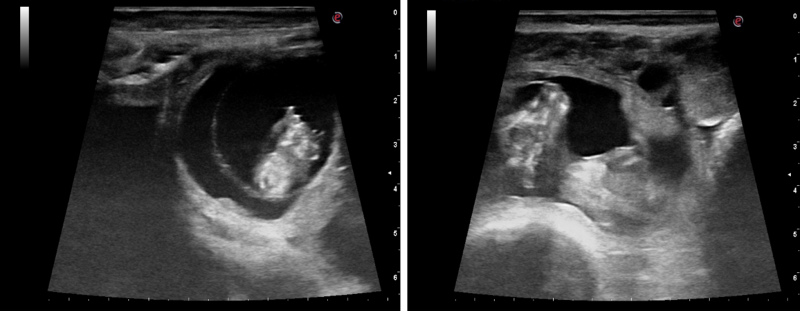
Figure 2: Ultrasonography image of the uterine body of a pregnant cow at 45 and 75 days (NFREC Repro Lab, 2022).
–
Blood Test
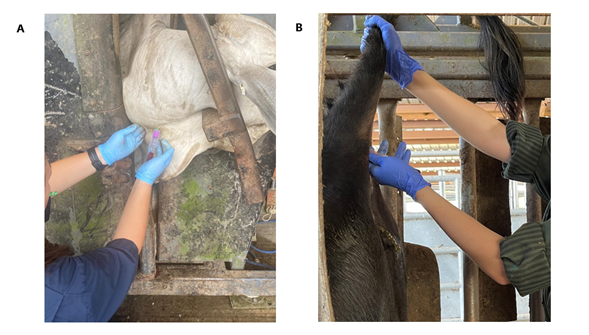
Figure 3: Blood collection in the jugular vein (B) Blood collection in the coccygeal vein (NFREC Repro Lab, 2022)
Some specific proteins can be detected in cows’ blood during pregnancy. The most commonly used protein for the identification of pregnant females is pregnancy-associated glycoproteins (PAGs), which are released by the placenta and can be detected by day 26 after conception (Filho et al., 2020). There are several commercial tests available for producers to purchase. To perform any of these tests, you need a small sample of blood (2 to 5 cc or mL) from the jugular vein in the neck (Image 4A) or coccygeal vein in the tail (Image 4B). Samples should be taken in an EDTA tube and labeled with the specific cow identification (ID).
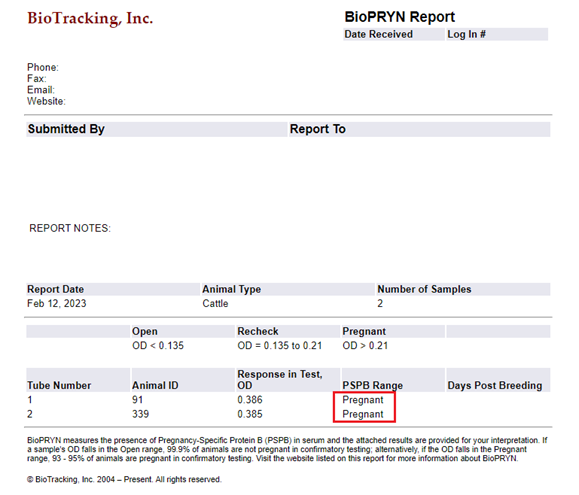
Figure 4: Laboratory Results Report, in red positive results of the two samples sent for analysis NFREC Repro Lab, 2023) (BioTracking©, 2023)
Depending on the test type, blood samples will be sent to a laboratory (Image 5) or can be processed chute-side (Image 6). The results can be ready as fast as 20 minutes or may take a couple of days, depending on the test acquired. The average cost of the test per animal is approximately $5; this cost could vary depending on the number of samples and the chosen test (Szenci, 2021). The results of this test are very accurate (95-99%), but the precision will depend on the age of the pregnancy, how many calves the animal has produced (parity), days since calving (post-partum), presence of twins, embryonic mortality, and milk production (Pohler et al., 2016).
–
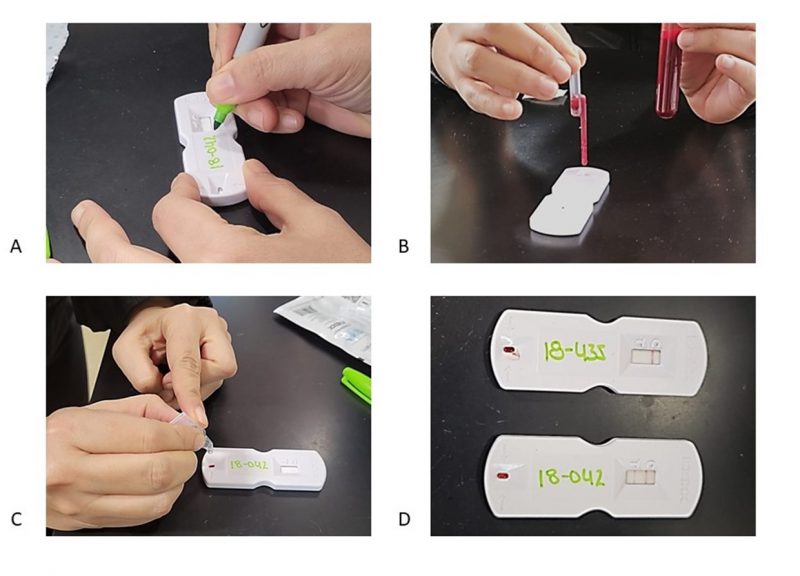
Figure 5: Steb-by Step of the Alertys OnFarm Pregnancy Test (Idexx). (A) Label the device (B) Add a drop of the blood with the pipette (C) Add wash solution (D) Results after 20min, negative result on the top and positive result on the bottom. Pictures by the NFREC Repro Lab, 2023.
–
Take-Home Message
Every cow-calf operation can benefit economically by adding one of the described pregnancy diagnosis strategies into their herd management; if a producer has 100 cows and, after the breeding season, decides not to do a pregnancy diagnosis, and 20% of cows are open until the calving season, they would be spending around $6300 to feed the open cows. But if they decide to use, for example, a blood test and take the open cows out of the herd, they will spend $500 on the test and save $5800 in feed cost alone. Therefore, it is important for producers to use pregnancy diagnoses on their herds to identify open cows and make the most convenient managerial decisions. Infertile cows waste resources, so it is vital for the beef operation to identify those animals and remove them from the herd (Prevatt et al., 2018).
–
References
Balhara, A. K., Gupta, M., Singh, S., Mohanty, A. K., & Singh, I. (2013). Early pregnancy diagnosis in bovine: Current status and future directions. The Scientific World Journal, 2013.
Filho, R. V. O., Franco, G. A., Reese, S. T., Dantas, F. G., Fontes, P. L. P., Cooke, R. F., Rhinehart, J. D., Thompson, K. W., & Pohler, K. G. (2020). Using pregnancy associated glycoproteins (PAG) for pregnancy detection at day 24 of gestation in beef cattle. Theriogenology, 141, 128–133.
Fricke, P. M., Ricci, A., Giordano, J. O., & Carvalho, P. D. (2016). Methods for and Implementation of Pregnancy Diagnosis in Dairy Cows. In Veterinary Clinics of North America – Food Animal Practice (Vol. 32, Issue 1, pp. 165–180). W.B. Saunders.
Gonella, A. (2020, March). Honey, we need to talk about calving distribution. The Florida Cattleman and Livestock Journal, 62–63.
Griffith, A. (2018, June 27). The Cost of Keeping One Open Cow Can Pay to Have the Herd Pregnancy Checked. Ohio BEEF Cattle LetterA Publication of the Ohio State University Extension Beef Team. .
Marshall, T., Maples, J., & Coatney, K. (2022, March). Benefit–Cost Analysis of Selling Pregnant Replacement Females: Information and Timing Matters. Mississippi State University Extension .
NAHMS. 2020. Beef 2017: Beef Cow-Calf Management Practices in the United States, 2017. Accessed on November 1, 2021.
Peixoto, P. M., Hubner, A. M., Junior, W. M. C., Cunha, L. L., Garrett, E. F., Pohler, K. G., Dias, N. W., Mercadante, V. R. G., Canisso, I. F., & Lima, F. S. (2021). Characterization of pregnancy-associated glycoproteins and progesterone as a predictor of twins and conceptus loss in high-risk-pregnancy Holstein cows. Journal of Dairy Science, 104(4), 5034–5046.
Pohler, K. G., Peres, R. F. G., Green, J. A., Graff, H., Martins, T., Vasconcelos, J. L. M., & Smith, M. F. (2016). Use of bovine pregnancy-associated glycoproteins to predict late embryonic mortality in postpartum Nelore beef cows. Theriogenology, 85(9), 1652–1659. h
Prevatt, C., Lamb, G. C., Dahlen, C., Mercadante, V. R. G., & Waters, K. (2018). What Is the Economic Impact of Infertility in Beef Cattle? EDIS, 2018(4).
Ricci, A., Carvalho, P. D., Amundson, M. C., Fourdraine, R. H., Vincenti, L., & Fricke, P. M. (2015). Factors associated with pregnancy-associated glycoprotein (PAG) levels in plasma and milk of Holstein cows during early pregnancy and their effect on the accuracy of pregnancy diagnosis. Journal of Dairy Science, 98(4), 2502–2514.
Sasser, R. G. (1986). Detection of pregnancy by radioimmunoassay of a novel pregnancy- specific protein in serum of cows and a profile of serum concentrations during gestation. Biology of Reproduction, 35(4), 936–942.
Szenci, O. (2021). Recent possibilities for the diagnosis of early pregnancy and embryonic mortality in dairy cows. In Animals (Vol. 11, Issue 6). MDPI AG.
Taverne, M., & Noakes, D. E. (2018). Pregnancy and its diagnosis. In Veterinary Reproduction & Obstetrics (pp. 78–114). Elsevier.
Youngquist, R. S. (2007). Pregnancy Diagnosis. In Current Theraphy in LARGE ANIMAL THERIOGENOLOGY (pp. 294–303).
Zoli, A. P., Guilbault, L. A., Delahaut, P., Ortiz, W. B., & Beckers, J.-F. (1992). Radioimmunoassay of a Bovine Pregnancy-Associated Glycoprotein in Serum: Its Application for Pregnancy Diagnosis. Biology of Reproduction, 46(1), 83–92.
- Heat Stress and its Impact on Cattle Reproduction - March 14, 2025
- Fall is Here.Time for Pregnancy Testing Cattle! - September 13, 2024
- How Stress Impacts Cattle Reproduction - March 15, 2024
